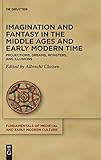Imagination and Fantasy in the Middle Ages and Early Modern Time : Projections, Dreams, Monsters, and Illusions / ed. by Albrecht Classen.
Material type: TextSeries: Fundamentals of Medieval and Early Modern Culture ; 24Publisher: Berlin ; Boston : De Gruyter, [2020]Copyright date: ©2020Description: 1 online resource (XIII, 807 p.)Content type:
TextSeries: Fundamentals of Medieval and Early Modern Culture ; 24Publisher: Berlin ; Boston : De Gruyter, [2020]Copyright date: ©2020Description: 1 online resource (XIII, 807 p.)Content type: - 9783110692945
- 9783110693782
- 9783110693669
- 128.3 23
- B105.I49 I53 2020
- online - DeGruyter
- Issued also in print.
| Item type | Current library | Call number | URL | Status | Notes | Barcode | |
|---|---|---|---|---|---|---|---|
 eBook
eBook
|
Biblioteca "Angelicum" Pont. Univ. S.Tommaso d'Aquino Nuvola online | online - DeGruyter (Browse shelf(Opens below)) | Online access | Not for loan (Accesso limitato) | Accesso per gli utenti autorizzati / Access for authorized users | (dgr)9783110693669 |
Frontmatter -- Contents -- List of illustrations -- Imagination, Fantasy, Otherness, and Monstrosity in the Middle Ages and the Early Modern World -- When Dreams Got Real: The Ontology of Dreaming in the Arabic Aristotelian Tradition -- Imaginary Creatures Causing Real Diseases: Projective Etiology in Medieval and Early Modern Medicine -- Political Ideals, Monstrous Counsel, and the Literary Imagination in Beowulf -- Who is Grendel in Beowulf? Ambiguity, Allegory, and Meaning -- Otherworldly Pilgrims: The Hell Tour and the Establishment of (Continental) Christian Territoriality on the Anglo-Saxon and Irish Peripheries -- On Monstrosity in the Shāhnāmah: Philosophizing with Żaḥḥāk -- The Negative Imagination: William IX’s Song Exactly About Nothing: “Farai un vers de dreit nien” -- Ladies, Warriors and Genies: Imagining Gender and Power in The Book of the Tales of Ziyad Ibn Amir al-Kinani -- The World of Hybrid Women in Medieval and Early Modern German Literature: Fantasy Images, Fascination, and Terror -- The Myth of the Amazons in Medieval Spain -- Wonders and Monsters in The Travels of John Mandeville and in Abu Hamid al-Gharnāti’s Tuhfat al-Albāb -- Are Dreams Gender-Related? The Function of Dreams in Middle High German Narrative Literature -- Monstra nobiscum: Medieval and Early Modern Teratology and the Confluence of Imaginatio and Scientia -- Jews and Anti-Jewish Fantasies in Christian Imagination in the Middle Ages -- The Life of Christ in Medieval Bestiaries: Imagining the Griffin, Lion, Unicorn, Pelican, and Phoenix -- Monsters, Grotesques, and Other Marvels in the Later Medieval Imagination -- Fantastic Places, Objects, and Creatures in Fourteenth-Century Czech-Language Literature: Imagination During the Reign of the Luxembourg Dynasty -- The Mermaid of Edam and the Emergence of Dutch National Identity -- Dream and Prophetic Projection in Andreas Gryphius’s Historical Tragedies: Traces of the Symbol -- The Shadow of the Knight: Phantom Fears and their Distortions of Reality in Baroque Spanish Theater -- Fantasy, Imagination, and Vision in Thomas Vaughan’s Lumen de Lumine -- Biographies of the Contributors -- Index
restricted access online access with authorization star
http://purl.org/coar/access_right/c_16ec
The notions of other peoples, cultures, and natural conditions have always been determined by the epistemology of imagination and fantasy, providing much freedom and creativity, and yet have also created much fear, anxiety, and horror. In this regard, the pre-modern world demonstrates striking parallels with our own insofar as the projections of alterity might be different by degrees, but they are fundamentally the same by content. Dreams, illusions, projections, concepts, hopes, utopias/dystopias, desires, and emotional attachments are as specific and impactful as the physical environment. This volume thus sheds important light on the various lenses used by people in the Middle Ages and the early modern age as to how they came to terms with their perceptions, images, and notions. Previous scholarship focused heavily on the history of mentality and history of emotions, whereas here the history of pre-modern imagination, and fantasy assumes center position. Imaginary things are taken seriously because medieval and early modern writers and artists clearly reveal their great significance in their works and their daily lives. This approach facilitates a new deep-structure analysis of pre-modern culture.
Issued also in print.
Mode of access: Internet via World Wide Web.
In English.
Description based on online resource; title from PDF title page (publisher's Web site, viewed 28. Feb 2023)


